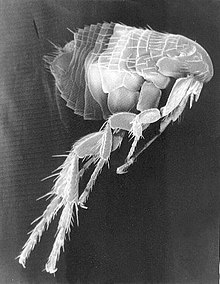Wikijunior:Bugs/Flea
What does it look like?
[edit | edit source]
Fleas are wingless insects about 1/25-inch long. Their flattened brown, shiny bodies are covered with bristles and spines. They have six long gangly legs. The backward-pointing, comb-like structures behind the head are called ctenidia. Some species have a row of bristles called a genal comb on the lower front of the head. They have compound eyes and their short antennae are normally hidden in grooves. They have specialized “knife-and-straw” mouthparts for ripping into skin and sucking bodily fluids. There are 18 families and about 2000 species of fleas. They belong to the Order Siphonaptera.
Where does it live?
[edit | edit source]Fleas are found in various habitats--dog dens, gopher burrows, and nests. Some species like the European Rabbit Flea live in nests containing newborn animals. Rodent Fleas occur worldwide, but are found mainly in the Northern Hemisphere. Sticktight Fleas are common in the warmer climates of the southeastern United States. Carnivore Fleas occur in the West. Chigoe fleas occur in tropical areas--Caribbean, Africa and South America.
What does it eat?
[edit | edit source]Fleas are ectoparasites, meaning they live on the outside of their host animal and feed on it without killing it. Before biting they lubricate an area with a special saliva to prevent clotting so the blood moves easily. Larvae feed on detritus left behind by adult fleas.
Rodent Fleas feed on mice, wood rats, and other rodents; a few attack birds. Sticktight Fleas feed on poultry, birds, and mammals. Malacopsyllid Fleas are parasites of opossums and rats. Carnivore Fleas feed on large meat-eaters such as wolves and bears.
How does it defend itself?
[edit | edit source]Fleas are easily able to jump away from danger using a structure called the pleural arch in the hind leg. It is made of a rubberlike protein called resilin. When a flea prepares to jump, the pleural arch is compressed to keep muscle energy stored. When released, most of the stored energy is suddenly unleashed. This causes the hind leg to snap straight, lifting the flea’s body. When the tips of the hind legs leave the surface, the flea can stay airborne for as long as 1/10 of a second.
A camouflaging layer of dust on sticky new cocoons offers some protection to larvae.
What stages of metamorphosis does it go through?
[edit | edit source]Fleas undergo complete metamorphosis involving an egg, a legless larva, a pupa, and an adult. Most female fleas lay only a few eggs at a time. A few weeks after hatching from the egg, the larva spins a silken cocoon and pupates inside the cocoon. Adult fleas emerge from the cocoon when they sense the presence of a host. Depending on the temperature, the pupa might transform into an adult flea anywhere from a week to a year. Newly emerged adult fleas can live only about one week without feeding. However, completely developed adults can live inside their puparia, for several months without eating.
Fleas need to eat while mating. Males need food energy for stamina and females need it for ovulating. A few hours after mating, females lay eggs on the host itself or in the nest or burrow.
What special behavior does it exhibit?
[edit | edit source]Fleas have amazing jumping ability. They can jump 150 times their height upward and 80 times their height horizontally.
Fleas usually find a host by detecting body heat. They can also detect carbon dioxide from the host's breath. Mouse Fleas are different. Instead of detecting carbon dioxide from the host, they recognize the mouse’s odor.
Rabbit fleas are sensitive to hosts’ hormones and mate only when the rabbits do.
Most fleas move freely on and off their hosts, but some like female Chigoes (sand fleas) attach themselves permanently to their hosts. They fix themselves to peoples’ feet, usually under toenails. The resulting swelling can grow to the size of a pea. Female Sticktite Fleas also attach themselves permanently to their hosts.
How does this bug affect people?
[edit | edit source]Flea bites leave itching red welts and the saliva may cause some people to have an allergic reaction.
Dog Fleas carry tapeworms that harm dogs, cats, and humans. Cat scratch disease is carried by Cat Fleas, but is usually transmitted by a cat scratch. Some flea species carry the Myxoma virus. Fleas that carry the Myxoma virus transmit deadly myxomatosis in rabbits.
Fleas carry the human disease endemic typhus, which killed many soldiers in World War I. Some scientists believe a bacterium carried by rat fleas caused bubonic plague, a disease that ravaged Europe in the Middle Ages. Others believe the plague is transmitted from one rodent to another, but not to humans.
References
[edit | edit source]Abarbanel, J. & Swimmer, J. (2007). A field guide to household bugs. New York, NY: Penguin Group.
Borror, D. J. & White, R. E. (1970). A field guide to insects America north of Mexico. New York, NY: Houghton Mifflin Company.
Marshall, S. A. (2006). Insects and their natural history and diversity. Richmond Hill, Ont: Firefly Books.
McGavin, G. C. (2000). Insects spiders and other terrestrial arthropods. New York, NY: Dorling Kindersley Inc.
Understanding science and nature. Insects and spiders. (1993). Alexandria, VA: Time-Life.
